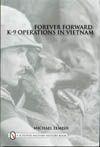 Their tours of duty would last about as long as they could still stand, and then they very rarely got to go home. Some 4,000 military working dogs served faithfully alongside their American masters, frequently engaging the enemy and ultimately credited with averting an estimated 10,000 American casualties. Military dog historian Michael Lemish’s latest book, Forever Forward: K-9 Operations in Vietnam, offers a comprehensive examination of dogs in that conflict.
Their tours of duty would last about as long as they could still stand, and then they very rarely got to go home. Some 4,000 military working dogs served faithfully alongside their American masters, frequently engaging the enemy and ultimately credited with averting an estimated 10,000 American casualties. Military dog historian Michael Lemish’s latest book, Forever Forward: K-9 Operations in Vietnam, offers a comprehensive examination of dogs in that conflict.
Lemish has served as the official historian of the Vietnam Dog Handlers Association and is a longtime advocate for the recognition of Vietnam’s working dogs. He has also authored War Dogs: Canines in Combat and War Dogs: A History of Loyalty and Heroism. While his latest work is focused on just Vietnam, Lemish gives readers a short course on the history of war dogs and, for those less familiar with the conflict, a tight overview of how the United States got into Vietnam.
While Forever Forward has somewhat of a textbook feel and uses only black and white photography, Lemish’s writing is crisp, and the many stories intertwined with the encyclopedic details are filled with warmth and emotion. Even though the photos are not in color, they still paint a vivid picture of the affection and bonds that were forged between dogs and handlers in the combat zone.
But playing on the deep history of the man and canine kinship is not the point for Lemish. Rather, it is the recognition of the important role these animals played on a daily basis, be it working as scouts, trackers, detectors or sentries, that the author so well conveys. Even for those familiar with dogs in general and military dogs in particular, Lemish brings little-known facets to light. Likewise, he takes readers into the lives, and sometimes minds, of the men whose partners had four legs. They were pretty much the same as all the others who wore a uniform and found themselves in Vietnam: “Some volunteered and had a background in working with dogs. Others already walking point found the opportunity to learn the dog handler trade with on-the-job-training.” And Lemish writes, “For the most part, dog handlers cut across racial lines, came from blue-collar families, and were comprised of men who never had a legitimate chance for a deferment.”
What most handlers came to realize, in an organization dependent on hardware to do its job, their dogs were relegated by the military establishment simply as equipment. The reality was, this “equipment” was not an inanimate tool that came with an operator’s manual, but rather a living, thinking creature that felt pain “and often shared the same happiness as his master.”
When human lives are torn asunder in war, can, or should, a dog be venerated as a “hero?” Even the hard-hearted will find it hard to deny that honorific in light of some of the documented cases Lemish describes, perhaps none as much as the story of a German Shepherd named Nemo and his four-legged comrades at Ton Son Nhut on December 4, 1966. While Nemo survived a bullet that took out an eye before exiting through his mouth, Rebel, Cubby and Toby, along with handler George Bevich, died fending off Viet Cong sappers, effectively giving the base defenders enough warning and time to beat them back. Nemo was the first sentry dog to be officially retired from active duty in Vietnam.
While Gareth Crocker’s new novel, Finding Jack, gets rave reviews for its tale of a Vietnam War dog handler’s attempt to rescue his yellow Lab, which he has been ordered to leave behind, Lemish’s exhaustive work shines a spotlight on the true stories of dogs in the Vietnam War. But the novel’s portrayal of mutual affection and dedication is not fiction. As Lemish writes: “Many dogs carried the same name, even looked the same, but each was an individual in their own right. Whether it was a particular bark or wag of their tail, their eyes would always carry the same message to their masters—one of honesty and supreme trust.”
Shiffer Military History, 2010




